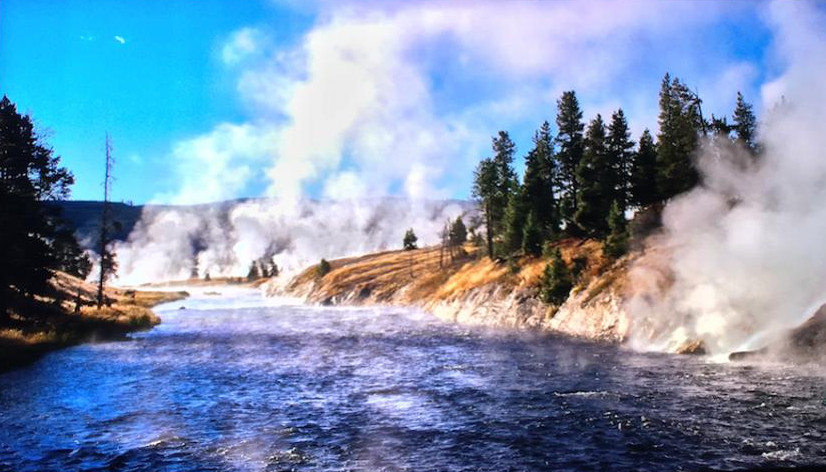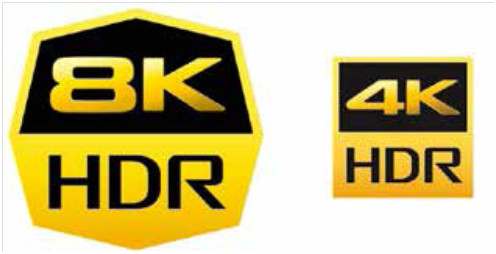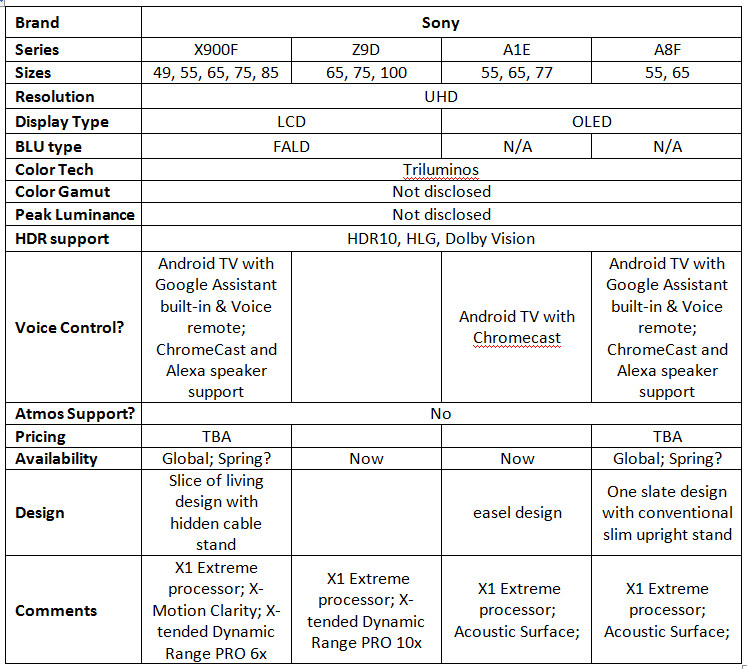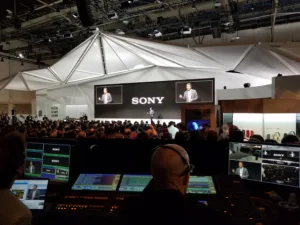Key Messages
One of the key messages from Kazuo Hirai, Sony’s CEO, speaking at their press conference was the company’s TV focus. “We have really shifted our product focus to more high-end [products] with 4K and OLED, and from a profits point of view, it is now a very stable business for us.”
This focus was evident in a refreshed line of OLED and LCD TVs, a new 4K projector model, a world’s first tech demo, plus new audio products. Sony has always had exceptional image processing and this expertise continues.
Full Spec 8K HDR
Perhaps the most interesting demo at CES was in the Sony booth where they showed a display was said to be capable of showing 10K cd/m². Of course when we asked how big a window size could support this level of luminance and for how long, we got no response. The Perceptual Quantizer (PQ) EOTF curve does support code values up to 10K cd/m², but this is the first time a company has claimed to actually be able to deliver this level of luminance in a flat panel solution.
Dolby has done this with projection based solutions in order to evaluate human preferences to luminance levels in content – which was the basis for the formation of the PQ curve. In private conversations with Dolby, we learned that they also have a prototype that can now produce 8K cd/m² and we saw another demo at 5K cd/m² as well, so there seems to be growing interest in pushing the luminance up higher.
Naturally, no one wants or expects the display to show a full white image at 5K, 8K or 10K cd/m². Most think that only highlights will be shown at this level, but very bright sky scenes and snow scenes could easily demand high luminance levels if the desire was to offer a more realistic image. Viewing these in a dark room would be a bit painful, however, so some adaptation of the signal based on the ambient light and the adaption state of viewer will probably be necessary for these extra bright displays.
Nevertheless, the Sony demo was extremely impressive. It was showcased next to the current 75” Z9D top of the line HDR display with perhaps 1800 cd/m² of peak luminance. The difference was striking – almost like comparing SDR to HDR except this is a comparison of HDR vs. Super HDR. The images were just stunning – more lifelike than I have seen before. But they were not overly bright – even in the darkened room. I especially like the shots from Yellowstone hot springs as I had just visited them and their amazing colors were dead on and striking on this display. The racing cars were amazing as well.


The demo was called a “full spec” HDR display. It was an 85” form factor with 8K resolution and used the new X1 Ultimate SoC. It is based on Sony’s Backlight Master Drive technology, which it has previously demonstrated in a 4000 cd/m² UHD display. The number of LEDs, dimmable zones, color gamut, black levels, color volume, etc, were not disclosed.
One key point – this display does not require any tone mapping. If the content contains a signal that calls for 10K cd/m², this display will deliver it (with limitations that were not disclosed). Even the Dolby 4000 cd/m² Pulsar monitor does not do this. If content is above 4000 cd/m² in brightness, it is clipped to 4000 cd/m². As a result, Sony’s Phil Jones said that no one has ever seen content displayed above 4000 cd/m² as it has always been clipped or tone mapped.
It was unclear if the content that was being shown actually contained pixels that went to 10K cd/m², but Jones says some gaming content does go all the way to 10,000. When compared to the Z9D display (which was running the same content), many elements of the scenes were clearly brighter and more colorful. Since the PQ curve is absolute, luminance points below the tone mapping point in the Z9D TV (maybe 1400 cd/m²?) should be the same luminance. For example, if the road luminance is at 800 cd/m² it should be the same on both displays, but the yellow or red car colors and highlights can easily exceed the mastering peak luminance (which is likely either 1000 or 4000 cd/m²). In other words, the color volume of the prototype 10,000 cd/m² display is much larger than the Z9D so any luminance points above the Z9D tone mapping point will get tone mapped to fit the capabilities of the display – and look different than the prototype.
Jones noted that cameras like the Sony F65 can capture 10,000 cd/m² pixels, and you can use meters to verify the sensor is not saturated at that level, but there has never been a way to see these light points before on a real display. Sony PlayStation content can be encoded to these levels too.
Sony says this is only a prototype and they did not announce any commercialization plans.
(I also saw this display, but found some judder disconcerting – it wasn’t clear to me though whether this was because of the brightness or other aspect of the display – such as the 8K, which tends to make judder more noticeable – or whether it was the content. Man. Ed.)
Technology/Upgrades
Sony also announced upgrades to their TV SoC from last year’s X1 to this year’s X1 Extreme. It also showed the next generation version called the X1 Ultimate. The X1 Ultimate was powering the 8K 10,000 cd/m² display. The X1 Extreme powers both the new 2018 OLED and LCD TVs.
The 4K HDR Processor X1 Extreme incorporates three new technologies: Object-based HDR remaster, Super Bit Mapping 4K HDR and Dual database processing. Object-based HDR Remastering is designed to upgrade SDR content to HDR quality while Super Bit Mapping is designed to smooth color gradations to avoid banding issues when upconverting. The X1 Extreme goes to a dual database solution to speed up video processing. With the X1 Extreme, up to 16 objects can be identified and isolated for processing, which can be thought of as a custom tone/texture map for that object.
Last year’s X1 processor included database processing, but included HDR remastering and Super Bit Mapping. The older 4K X-Reality Pro processor loses the HDR remastering and Super Bit Mapping modules.
The X1 Extreme also includes the new X-Motion Clarity feature. This is Sony’s approach to reducing motion blur in LCD displays. Some companies use a scanning or blinking backlight and others use a black frame insertion technique. These techniques create a dimmer image, however.
Sony leverages the processing in the X1 Extreme to first identify faster moving objects in the scene. These are then inserted into a black frame with the moving object illuminated by the high density backlight. The overall luminance of the scene is also increased a bit so that the average APL before and after X-Motion Clarity is the same. Therefore, pictures are clear and smooth with virtually no loss in brightness.
Also announced is X-tended Dynamic Range PRO 6x. This is Sony’s FALD backlight engine which enhances HDR and non-HDR content by boosting and dimming the backlight levels precisely for each zone of the screen with a unique backlighting technology. They measure the improvement with a metric called “XDR Contrast” to signify the contrast users actually feel and experience compared to a TV without local dimming. The Z9D model has an XDR contrast of 10x but the X900F has 6x.
The next processer is called the X1 Ultimate, and Sony already has working samples. This is twice as powerful as the X1 Extreme and was powering the 8K 10,000 cd/m² demo in the dark room. It was also used to showcase the improvements it will offer in UHD LCD and OLED TVs as well with side-but-side demo that featured the X1 Extreme vs. X1 Ultimate on 85″ 8K LCD and 65″ 4K OLED sets. This showed that images looked crisper and cleaner with more vibrant colors. It seems likely this will be used in 2019 models, but Sony did not confirm this.
All of Sony’s 2018 TV are Android TV models with Google Assistant built-in, allowing your voice to discover and access to content, as well as control of other smart home devices through a Sony TV. The Google Assistant on Sony TV works just by pushing the microphone button on the remote and using your voice to ask a question or say a command. This allows users to seamlessly playback content, search for content, play music, stream photos, control their TV, control their smart home devices and find general information (e.g. weather, directions, fast facts, etc.) all through their TV. Furthermore, Sony’s Android TV works with popular smart speakers such as Sony’s own LF-S50G, Google Home or Amazon Alexa.
Sony has announced that Dolby Vision support will begin rolling out to select models of its 2016 and 2017 Android TVs. Just after CES, Sony made good on this promise by releasing firmware for the Sony A1E OLED, as well as the company’s Z9D, X94E and X93E LCDs. However, the update only supports streaming Dolby Vision content – not content coming across an HDMI interface, such as a Blu-ray player.
Sony has filed a trademark for “8K HDR” and a new corresponding logo, listed under the classification “Television receivers; light emitting diode (LED) displays.” The application went through in October, covering Europe, the US and Japan. The timing of the application suggests that Sony may be revealing its debut 8K TV soon.

OLED TVs
Sony introduced one new OLED series at CES – the A8F. It is essentially the same as last year’s A1E model with very similar picture performance specifications and the X1 Extreme processor. But there is an aesthetic change. Instead of the controversial angled easel with an integrated woofer, the A8F features a “new design that minimizes the footprint allowing A8F to be positioned in a wider range of locations” – in other words, a more traditional perpendicular vertical stand, with the woofer built onto the rear of the set.
The A8F retains the A1E’s Acoustic Surface technology that allows the screen to double as a speaker. The platform continues to be Android based with Google Assistant built in as well as support for Amazon Alexa or Google speakers (in some territories).
The A1E will continue into 2018.
LCD TVs
Sony announced one new line at CES 2018, the X900F series. This a full array local dimming model with the new X1 Extreme processor, X-Motion Clarity, and X-tended Dynamic Range Pro 6x. The Z9D will continue for 2018.

Blu-ray Player
Sony announced a new Ultra HD Blu-ray player, the UBP-X700, that now supports Dolby Vision playback. The X700 will carry apps, including the 4K versions of Netflix, Amazon Prime Video and YouTube, and will support a number of high-quality video and audio file formats, including MP4, DSD, and FLAC. It is unclear if last year’s X800 player will get a firmware update to support Dolby Vision playback, however.

